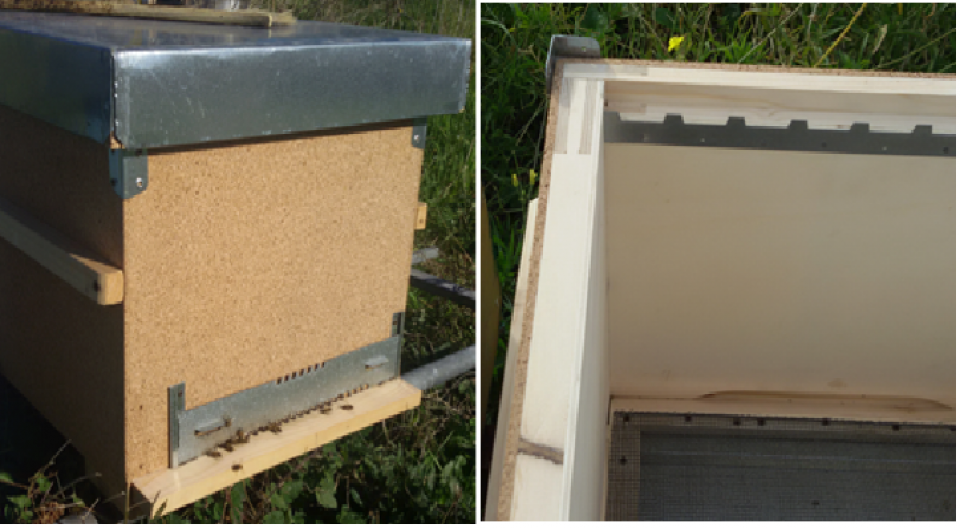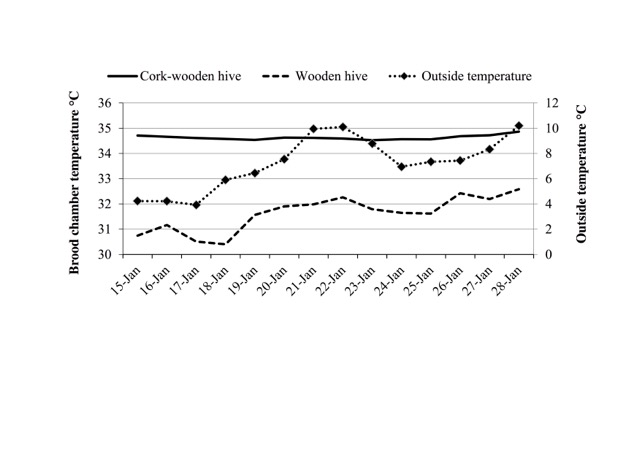
The aim of this trial was to : a) increase thermoregulation efficiency of beehives by using cork in the construction of hive walls, thus improving bee health and hive productivity; b) contribute to the maintenance of traditional apiculture practices of Mediterranean agro-silvo pastoral systems, as historical findings indicate a widespread use of cork for the construction of rustic hives; c) favour a better use of a secondary product of the cork processing industry (granulated cork); d) produce lighter and more resistant hives, compared to wooden hives; e) promote the use of cork as a fundamental product and economic source of revenue of traditional agro-forestry systems.
The insulating properties of cork as construction material of modern hives and its impact on thermoregulation of Italian bee (Apis mellifera ligustica) colonies, in comparison to traditional beehives made of fir wood was tested. The study was performed at the University of Sassari (NW Sardinia, Italy). Experimental Dadant-Blatt cork-wooden hives with 3 cm-thick walls made mostly of cork (83%) and only a thin inner layer of wood (0.5 cm) were compared with standard Dadant-Blatt fir wood hives, used as control. The experimental beehives were handcrafted in the woodworking facilities of Montarbu and Pixinamanna, managed by the Regional Forest Agency (FoReSTAS - Sardinia).
Compared to the control, experimental cork/wooden beehives demonstrated: a more regular pattern of internal daily temperature, more efficient winter thermoregulation, a shorter time lapse necessary for restoring the temperature of the hive after opening (referring to the brood chamber). For the latter, the decrease in temperature during the time of extraction of the frames (5 mins) was less in the cork/wooden hives compared to the wooden hives, reaching 32.06° C instead of 31.60° C; after closing the hive, cork/wooden hives took 12 minutes to reach 36.56° C, while wooden hives took 24 minutes to reach 35.10° C. Due to the lower heating needs a lower consumption of honey by the colonies during winter months was observed, with an average amount of 3.5 kg honey per hive saved in Mediterranean conditions.
The results suggest the use of cork for the construction of modern, but at the same time traditional, cork/wood beehives. This may contribute to a greater economic and environmental sustainability of multi-functional Mediterranean silvo-pastoral systems, but also to the reduction of fossil-based insulation materials, especially where winter temperatures can be lower than the ones experienced in the present study. As for construction details, the dimensions of the experimental cork-wooden hives, based on the Dadant-Blatt model, are 52.0 x 34.8 cm with 3- cm-thick walls made mostly of cork (83%) and only a thin inner layer of wood (0.5 cm).
The use of cork in the construction of modern beehives appears promising and could represent an interesting synergy between apiculture and cork oak woodland management. Considering the mild environmental conditions in the experimental site, interesting perspectives for increasing honey production in more severe climatic conditions can be expected. Further statistical confirmation is required by extending investigations to a larger number of hives and for longer periods. In particular, a hive too isolated from the external environment could experience problems related to internal overheating which, in this case, could not always be efficiently compensated by the regulatory function of bees.
The use of cork in the construction of modern hives provides a new possibility for enhancing the use of this non-wood forest product and improving the performance of hives, not only in the forest context. The use of this hive promotes traditional and sustainable use of Mediterranean agroforestry systems, thus contributing to their conservation. These contexts also provide beekeeping with a variety of nectar, pollen and resin resources throughout the year, ensuring regular bee colony development and reduced health risks. On the other hand, honey is an important resource for the enhancement and preservation of these systems.
Ignazio Floris, ifloris@uniss.it , https://agrariaweb.uniss.it/it
Michelina Pusceddu, mpusceddu@uniss.it , https://agrariaweb.uniss.it/it
Alberto Satta, albsatta@uniss.it , https://agrariaweb.uniss.it/it
Further information
Satta A., Floris I. 2004. Effects of the cork on the thermal insulation and the thermoregulation of beehive [Sardinia]. APOidea 1: 80-87.
Floris I., Bagella S., Caria M.C., Ruiu L., Buffa F., Satta, A. 2016 - A Mediterranean silvo-pastoral system supporting beehive health and productivity. Bulletin of Insectology 69 (1): 13-20.
Floris I., Pusceddu M., Raccimolo E., Casula A., Patteri G., Satta A., 2020 - The use of cork in the thermoregulation of the hive: an innovation attempt to enhance non-wood products and beekeeping in Mediterranean forests. Annals of Silvicultural Research, Annals of Silvicultural Research - ASR-2019-0006.R1 (in press).
I. Floris

Comparison between daily variations of the environmental temperature and those inside the hives, made of wood and cork or wood only (I.Floris)
